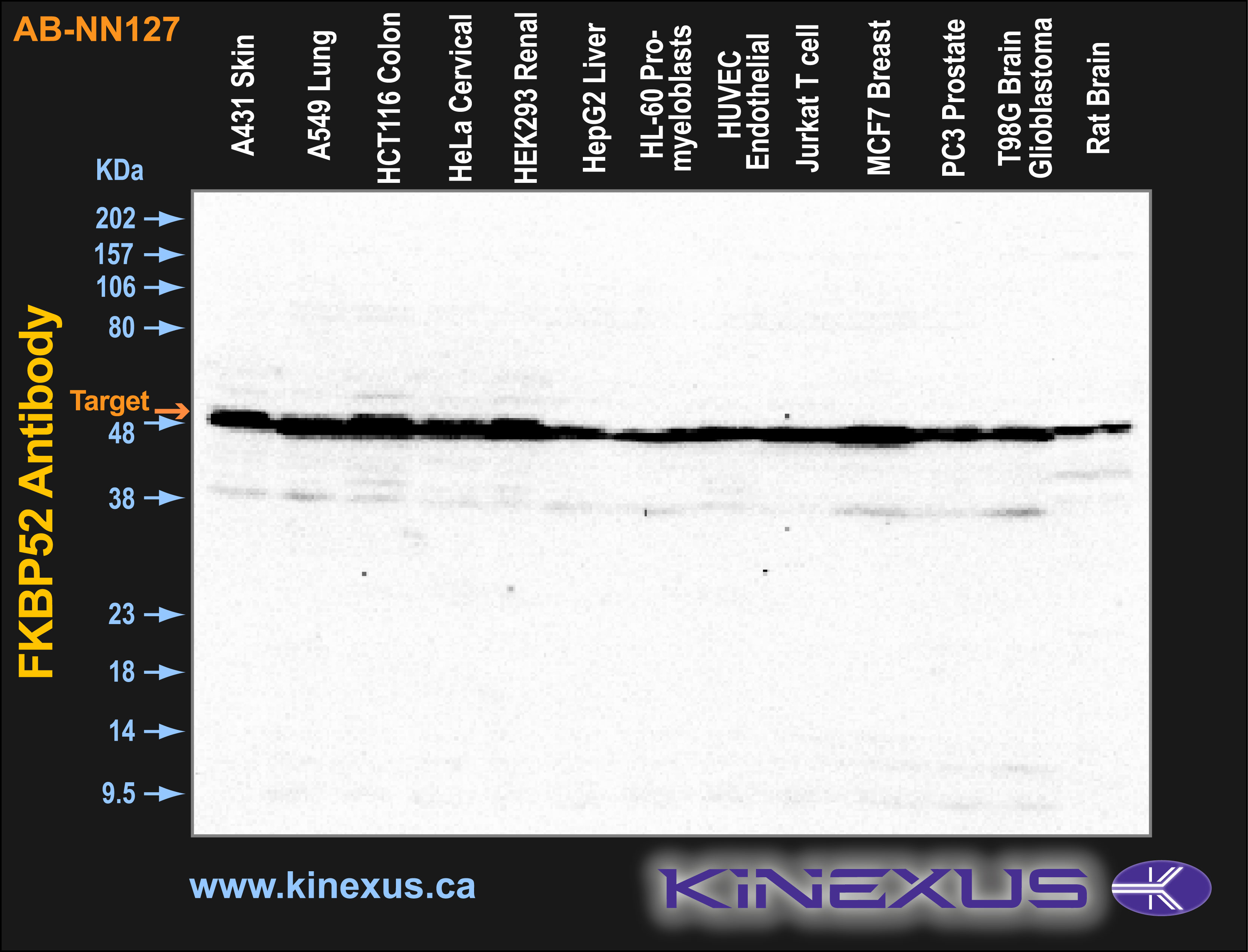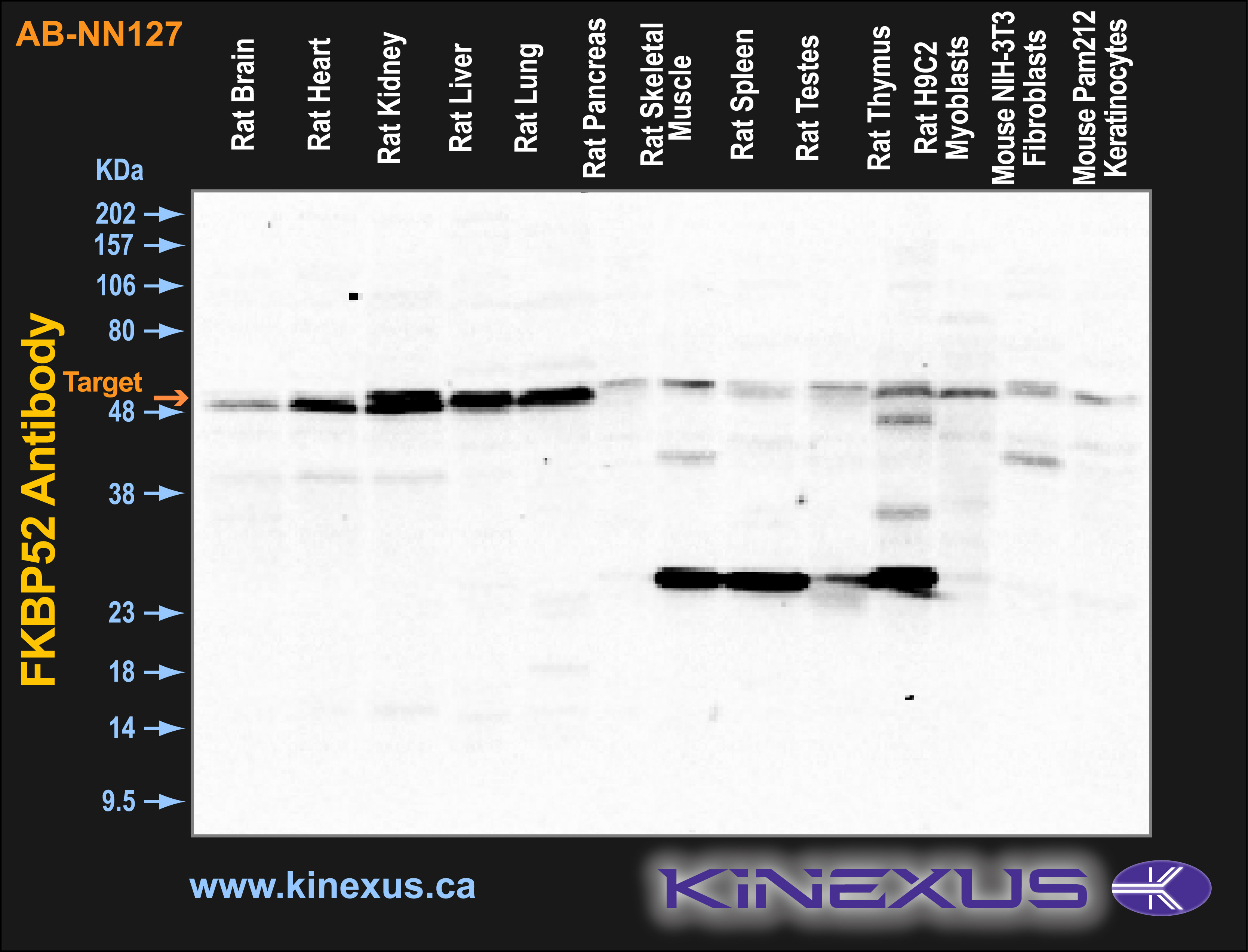Product Name: FKBP52
Product Number: AB-NN127
| Size: | 25 µg | Price: | 89.00 | |
| $US |
Target Full Name: Peptidyl-prolyl cis-trans isomerase FKBP4
Target Alias: FK506 binding protein 4; FKBP4; FKBP59; HBI; HSP56; p52; p59; PPIase; Rotamase; T cell FK506 binding protein
Product Type Specific: FK506 binding protein pan-specific antibody
Antibody Code: NN127
Antibody Target Type: Pan-specific
Protein UniProt: Q02790
Protein SigNET: Q02790
Antibody Type: Monoclonal
Antibody Host Species: Mouse
Antibody Ig Isotype Clone: IgG
Target Alias: FK506 binding protein 4; FKBP4; FKBP59; HBI; HSP56; p52; p59; PPIase; Rotamase; T cell FK506 binding protein
Product Type Specific: FK506 binding protein pan-specific antibody
Antibody Code: NN127
Antibody Target Type: Pan-specific
Protein UniProt: Q02790
Protein SigNET: Q02790
Antibody Type: Monoclonal
Antibody Host Species: Mouse
Antibody Ig Isotype Clone: IgG
Antibody Immunogen Source: Synthetic peptide corresponding to the residues of human FKBP52
Production Method: Protein G purified
Antibody Modification: Unconjugated. Contact KInexus if you are interest in having the antibody biotinylated or coupled with fluorescent dyes.
Antibody Concentration: 1 mg/ml
Storage Buffer: Phosphate buffered saline, 50% glycerol, 0.09% sodium azide
Storage Conditions: For long term storage, keep frozen at -40°C or lower. Stock solution can be kept at +4°C for more than 3 months. Avoid repeated freeze-thaw cycles.
Product Use: Western blotting | Immunohistochemistry | ICC/Immunofluorescence | Immunoprecipitation
Production Method: Protein G purified
Antibody Modification: Unconjugated. Contact KInexus if you are interest in having the antibody biotinylated or coupled with fluorescent dyes.
Antibody Concentration: 1 mg/ml
Storage Buffer: Phosphate buffered saline, 50% glycerol, 0.09% sodium azide
Storage Conditions: For long term storage, keep frozen at -40°C or lower. Stock solution can be kept at +4°C for more than 3 months. Avoid repeated freeze-thaw cycles.
Product Use: Western blotting | Immunohistochemistry | ICC/Immunofluorescence | Immunoprecipitation
Antibody Dilution Recommended: WB (1:2000), IHC (1:250), IP (5µg); optimal dilutions for assays should be determined by the user.
Antibody Potency: Medium potency. Detects a ~52 kDa protein in cell and tissue lysates by Western blotting. Heavy chain migrates close to FKBP52 on SDS-PAGE gels.
Antibody Species Reactivity: Human | Mouse | Rat | Dog | Hamster
Antibody Positive Control: 0.5 µg/ml was sufficient for detection of FKBP52 in 20 µg total protein using WB by colorimetric immunoblot analysis using Goat Anti-Mouse IgG:HRP as the secondary.
Antibody Specificity: Very high
Related Product 1: FKBP51 pan-specific antibody (Cat. No.: AB-NN249-1)
Antibody Potency: Medium potency. Detects a ~52 kDa protein in cell and tissue lysates by Western blotting. Heavy chain migrates close to FKBP52 on SDS-PAGE gels.
Antibody Species Reactivity: Human | Mouse | Rat | Dog | Hamster
Antibody Positive Control: 0.5 µg/ml was sufficient for detection of FKBP52 in 20 µg total protein using WB by colorimetric immunoblot analysis using Goat Anti-Mouse IgG:HRP as the secondary.
Antibody Specificity: Very high
Related Product 1: FKBP51 pan-specific antibody (Cat. No.: AB-NN249-1)
Scientific Background: HSP90 is crucial to cellular signaling by its regulation of the folding, activity, and stability of a wide range of client proteins. These client protein complexes may also contain one or more cochaperones (1). One class of HSP90-binding cochaperone is composed of proteins with a characteristic tetratricopeptide repeat (TPR) domain that forms an HSP90 binding site. Among the TPR cochaperones of HSP90 are Hop/Sti1, protein phosphatase PP5, and members of both the FK506- and cyclosporin A-binding families of immunophilins (2). FK506-binding protein 51 (FKBP51) and FKBP52 are large molecular weight immunophilins that are part of the mature glucocorticoid receptor (GR) heterocomplex (3).
The N terminal domain of each protein binds FK506 and has peptidyl-prolyl isomerase (PPIase) activity that converts prolyl peptide bonds within target proteins from cis- to trans- proline. The C-terminal domains contain the TPR repeats involved in protein-protein interactions with the HSP90 (4). Although FKBP52 and FKBP51 share ~75% sequence similarity, they affect hormone binding by glucocorticoid receptor in opposing manners and have different HSP90-binding characteristics (3).
FK506 binding protein 51 kDa (FKBP51 or otherwise referred to as FKBP54) has been identified as a progestininducible gene. This protein is predominantly expressed in murine T cells but in humans, it is abundantly expressed in numerous tissues at levels many times higher than FKBP12. The FKBP51 gene is known to be induced by glucocorticoids (5).
Figure 1. Immunoblotting of various cell lines with AB-NN127 antibody at a 1.5 µg/mL final concentration. The target protein FKBP52 is indicated. Each lane was loaded with 15 µg of cell lysate protein. The max signal count was 30842.
Figure 2. Immunoblotting of various tissue lines with AB-NN127 antibody at a 1.5 µg/mL final concentration. The target protein FKBP52 is indicated. Each lane was loaded with 15 µg of tissue lysate protein. The max signal count was 44350.
References
[1] Cheung-Flynn J., Roberts P.J., Riggs D.L., and Smith D.F. (2003) J. Biol. Chem. 278(19): 17388-17394.
[2] Davies T.H., Ning Y.N., and Sanchez E.R. (2002) J Biol. Chem. 277 (7): 4597-4600.
[3] Wu, B. et al. (2004) Proc. Natl. Acad. Sci. USA. 101(22): 8348-8353.
[4] Denny W.B., Prapapanich V., Smith D.F., and Scammell J.G. (2005) Endocrinology 146(7):3194-3201.
[5] Cox M.B. et al. (2007) Molecular Endocrinology. Epub.
[1] Cheung-Flynn J., Roberts P.J., Riggs D.L., and Smith D.F. (2003) J. Biol. Chem. 278(19): 17388-17394.
[2] Davies T.H., Ning Y.N., and Sanchez E.R. (2002) J Biol. Chem. 277 (7): 4597-4600.
[3] Wu, B. et al. (2004) Proc. Natl. Acad. Sci. USA. 101(22): 8348-8353.
[4] Denny W.B., Prapapanich V., Smith D.F., and Scammell J.G. (2005) Endocrinology 146(7):3194-3201.
[5] Cox M.B. et al. (2007) Molecular Endocrinology. Epub.
© Kinexus Bioinformatics Corporation 2017



